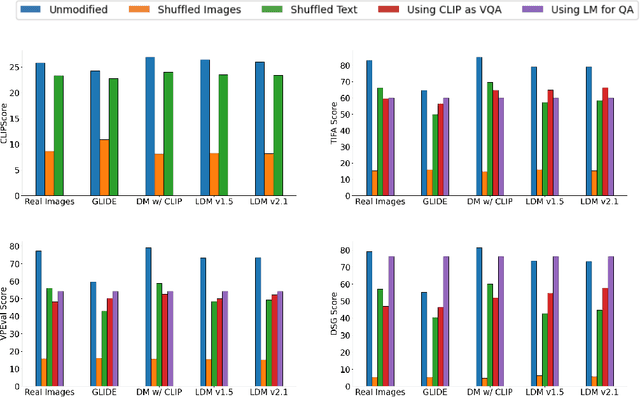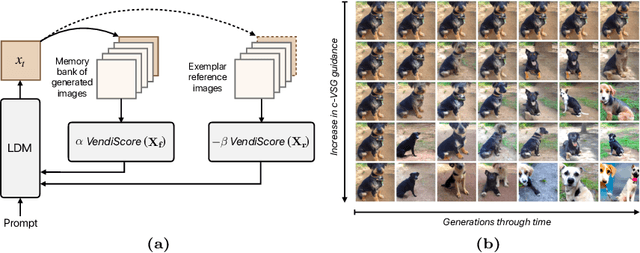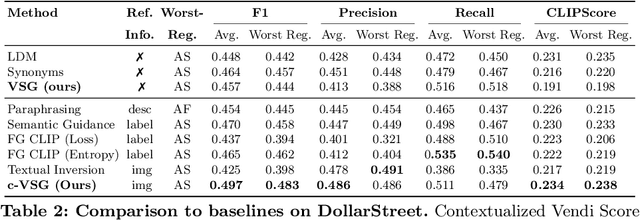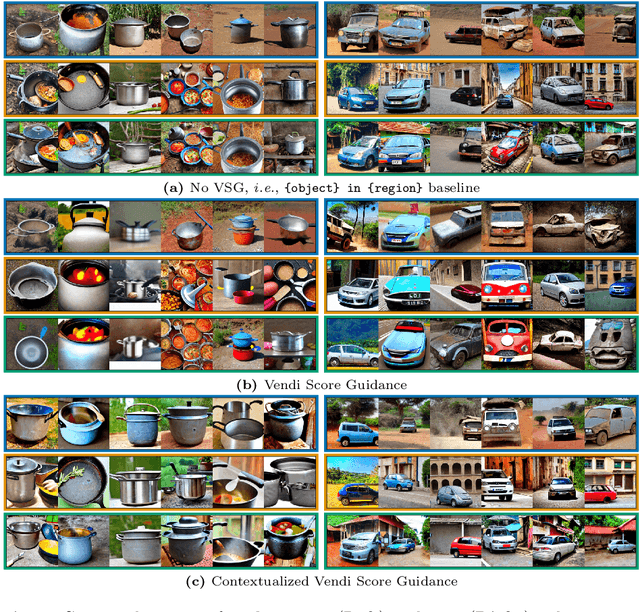Candace Ross
A Shortcut-aware Video-QA Benchmark for Physical Understanding via Minimal Video Pairs
Jun 11, 2025Abstract:Existing benchmarks for assessing the spatio-temporal understanding and reasoning abilities of video language models are susceptible to score inflation due to the presence of shortcut solutions based on superficial visual or textual cues. This paper mitigates the challenges in accurately assessing model performance by introducing the Minimal Video Pairs (MVP) benchmark, a simple shortcut-aware video QA benchmark for assessing the physical understanding of video language models. The benchmark is comprised of 55K high-quality multiple-choice video QA examples focusing on physical world understanding. Examples are curated from nine video data sources, spanning first-person egocentric and exocentric videos, robotic interaction data, and cognitive science intuitive physics benchmarks. To mitigate shortcut solutions that rely on superficial visual or textual cues and biases, each sample in MVP has a minimal-change pair -- a visually similar video accompanied by an identical question but an opposing answer. To answer a question correctly, a model must provide correct answers for both examples in the minimal-change pair; as such, models that solely rely on visual or textual biases would achieve below random performance. Human performance on MVP is 92.9\%, while the best open-source state-of-the-art video-language model achieves 40.2\% compared to random performance at 25\%.
DIMCIM: A Quantitative Evaluation Framework for Default-mode Diversity and Generalization in Text-to-Image Generative Models
Jun 05, 2025Abstract:Recent advances in text-to-image (T2I) models have achieved impressive quality and consistency. However, this has come at the cost of representation diversity. While automatic evaluation methods exist for benchmarking model diversity, they either require reference image datasets or lack specificity about the kind of diversity measured, limiting their adaptability and interpretability. To address this gap, we introduce the Does-it/Can-it framework, DIM-CIM, a reference-free measurement of default-mode diversity ("Does" the model generate images with expected attributes?) and generalization capacity ("Can" the model generate diverse attributes for a particular concept?). We construct the COCO-DIMCIM benchmark, which is seeded with COCO concepts and captions and augmented by a large language model. With COCO-DIMCIM, we find that widely-used models improve in generalization at the cost of default-mode diversity when scaling from 1.5B to 8.1B parameters. DIMCIM also identifies fine-grained failure cases, such as attributes that are generated with generic prompts but are rarely generated when explicitly requested. Finally, we use DIMCIM to evaluate the training data of a T2I model and observe a correlation of 0.85 between diversity in training images and default-mode diversity. Our work provides a flexible and interpretable framework for assessing T2I model diversity and generalization, enabling a more comprehensive understanding of model performance.
Multi-Modal Language Models as Text-to-Image Model Evaluators
May 01, 2025Abstract:The steady improvements of text-to-image (T2I) generative models lead to slow deprecation of automatic evaluation benchmarks that rely on static datasets, motivating researchers to seek alternative ways to evaluate the T2I progress. In this paper, we explore the potential of multi-modal large language models (MLLMs) as evaluator agents that interact with a T2I model, with the objective of assessing prompt-generation consistency and image aesthetics. We present Multimodal Text-to-Image Eval (MT2IE), an evaluation framework that iteratively generates prompts for evaluation, scores generated images and matches T2I evaluation of existing benchmarks with a fraction of the prompts used in existing static benchmarks. Moreover, we show that MT2IE's prompt-generation consistency scores have higher correlation with human judgment than scores previously introduced in the literature. MT2IE generates prompts that are efficient at probing T2I model performance, producing the same relative T2I model rankings as existing benchmarks while using only 1/80th the number of prompts for evaluation.
EvalGIM: A Library for Evaluating Generative Image Models
Dec 18, 2024



Abstract:As the use of text-to-image generative models increases, so does the adoption of automatic benchmarking methods used in their evaluation. However, while metrics and datasets abound, there are few unified benchmarking libraries that provide a framework for performing evaluations across many datasets and metrics. Furthermore, the rapid introduction of increasingly robust benchmarking methods requires that evaluation libraries remain flexible to new datasets and metrics. Finally, there remains a gap in synthesizing evaluations in order to deliver actionable takeaways about model performance. To enable unified, flexible, and actionable evaluations, we introduce EvalGIM (pronounced ''EvalGym''), a library for evaluating generative image models. EvalGIM contains broad support for datasets and metrics used to measure quality, diversity, and consistency of text-to-image generative models. In addition, EvalGIM is designed with flexibility for user customization as a top priority and contains a structure that allows plug-and-play additions of new datasets and metrics. To enable actionable evaluation insights, we introduce ''Evaluation Exercises'' that highlight takeaways for specific evaluation questions. The Evaluation Exercises contain easy-to-use and reproducible implementations of two state-of-the-art evaluation methods of text-to-image generative models: consistency-diversity-realism Pareto Fronts and disaggregated measurements of performance disparities across groups. EvalGIM also contains Evaluation Exercises that introduce two new analysis methods for text-to-image generative models: robustness analyses of model rankings and balanced evaluations across different prompt styles. We encourage text-to-image model exploration with EvalGIM and invite contributions at https://github.com/facebookresearch/EvalGIM/.
What makes a good metric? Evaluating automatic metrics for text-to-image consistency
Dec 18, 2024



Abstract:Language models are increasingly being incorporated as components in larger AI systems for various purposes, from prompt optimization to automatic evaluation. In this work, we analyze the construct validity of four recent, commonly used methods for measuring text-to-image consistency - CLIPScore, TIFA, VPEval, and DSG - which rely on language models and/or VQA models as components. We define construct validity for text-image consistency metrics as a set of desiderata that text-image consistency metrics should have, and find that no tested metric satisfies all of them. We find that metrics lack sufficient sensitivity to language and visual properties. Next, we find that TIFA, VPEval and DSG contribute novel information above and beyond CLIPScore, but also that they correlate highly with each other. We also ablate different aspects of the text-image consistency metrics and find that not all model components are strictly necessary, also a symptom of insufficient sensitivity to visual information. Finally, we show that all three VQA-based metrics likely rely on familiar text shortcuts (such as yes-bias in QA) that call their aptitude as quantitative evaluations of model performance into question.
Findings of the Second BabyLM Challenge: Sample-Efficient Pretraining on Developmentally Plausible Corpora
Dec 06, 2024Abstract:The BabyLM Challenge is a community effort to close the data-efficiency gap between human and computational language learners. Participants compete to optimize language model training on a fixed language data budget of 100 million words or less. This year, we released improved text corpora, as well as a vision-and-language corpus to facilitate research into cognitively plausible vision language models. Submissions were compared on evaluation tasks targeting grammatical ability, (visual) question answering, pragmatic abilities, and grounding, among other abilities. Participants could submit to a 10M-word text-only track, a 100M-word text-only track, and/or a 100M-word and image multimodal track. From 31 submissions employing diverse methods, a hybrid causal-masked language model architecture outperformed other approaches. No submissions outperformed the baselines in the multimodal track. In follow-up analyses, we found a strong relationship between training FLOPs and average performance across tasks, and that the best-performing submissions proposed changes to the training data, training objective, and model architecture. This year's BabyLM Challenge shows that there is still significant room for innovation in this setting, in particular for image-text modeling, but community-driven research can yield actionable insights about effective strategies for small-scale language modeling.
Improving Model Evaluation using SMART Filtering of Benchmark Datasets
Oct 26, 2024



Abstract:One of the most challenging problems facing NLP today is evaluation. Some of the most pressing issues pertain to benchmark saturation, data contamination, and diversity in the quality of test examples. To address these concerns, we propose Selection Methodology for Accurate, Reduced, and Targeted (SMART) filtering, a novel approach to select a high-quality subset of examples from existing benchmark datasets by systematically removing less informative and less challenging examples. Our approach applies three filtering criteria, removing (i) easy examples, (ii) data-contaminated examples, and (iii) examples that are similar to each other based on distance in an embedding space. We demonstrate the effectiveness of SMART on three multiple choice QA datasets, where our methodology increases efficiency by reducing dataset size by 48\% on average, while increasing Pearson correlation with rankings from ChatBot Arena, a more open-ended human evaluation setting. Our method enables us to be more efficient, whether using SMART to make new benchmarks more challenging or to revitalize older datasets, while still preserving the relative model rankings.
Changing Answer Order Can Decrease MMLU Accuracy
Jun 27, 2024



Abstract:As large language models (LLMs) have grown in prevalence, particular benchmarks have become essential for the evaluation of these models and for understanding model capabilities. Most commonly, we use test accuracy averaged across multiple subtasks in order to rank models on leaderboards, to determine which model is best for our purposes. In this paper, we investigate the robustness of the accuracy measurement on a widely used multiple choice question answering dataset, MMLU. When shuffling the answer label contents, we find that all explored models decrease in accuracy on MMLU, but not every model is equally sensitive. These findings suggest a possible adjustment to the standard practice of leaderboard testing, where we additionally consider the percentage of examples each model answers correctly by random chance.
Improving Geo-diversity of Generated Images with Contextualized Vendi Score Guidance
Jun 06, 2024



Abstract:With the growing popularity of text-to-image generative models, there has been increasing focus on understanding their risks and biases. Recent work has found that state-of-the-art models struggle to depict everyday objects with the true diversity of the real world and have notable gaps between geographic regions. In this work, we aim to increase the diversity of generated images of common objects such that per-region variations are representative of the real world. We introduce an inference time intervention, contextualized Vendi Score Guidance (c-VSG), that guides the backwards steps of latent diffusion models to increase the diversity of a sample as compared to a "memory bank" of previously generated images while constraining the amount of variation within that of an exemplar set of real-world contextualizing images. We evaluate c-VSG with two geographically representative datasets and find that it substantially increases the diversity of generated images, both for the worst performing regions and on average, while simultaneously maintaining or improving image quality and consistency. Additionally, qualitative analyses reveal that diversity of generated images is significantly improved, including along the lines of reductive region portrayals present in the original model. We hope that this work is a step towards text-to-image generative models that reflect the true geographic diversity of the world.
An Introduction to Vision-Language Modeling
May 27, 2024


Abstract:Following the recent popularity of Large Language Models (LLMs), several attempts have been made to extend them to the visual domain. From having a visual assistant that could guide us through unfamiliar environments to generative models that produce images using only a high-level text description, the vision-language model (VLM) applications will significantly impact our relationship with technology. However, there are many challenges that need to be addressed to improve the reliability of those models. While language is discrete, vision evolves in a much higher dimensional space in which concepts cannot always be easily discretized. To better understand the mechanics behind mapping vision to language, we present this introduction to VLMs which we hope will help anyone who would like to enter the field. First, we introduce what VLMs are, how they work, and how to train them. Then, we present and discuss approaches to evaluate VLMs. Although this work primarily focuses on mapping images to language, we also discuss extending VLMs to videos.
 Add to Chrome
Add to Chrome Add to Firefox
Add to Firefox Add to Edge
Add to Edge